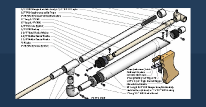Materials/Tools Needed:
-Dremel with a small sanding drum, or any other abrasive bit.
-AT3K pump
-Hacksaw
-Wire Cutters
-Supermaxx 1500 (duh)
Step one:
Take your trigger and grind it down with your dremel so it appears as shown. The two spots circled are where the trigger needs to be shaved down. What this does is allows the trigger to go further back, and allows the spring to "load up" more so that it stores more energy, and thus propels the rod faster for a faster air release.

Step two:
Cut down your shell to allow the trigger to go further back. There will be a little dimple in the piece of plastic that prevents your trigger from moving back. This is where you need to cut to. Any more is unnecessary. You must do this on both sides of the shell.


Step three:
You are now going to replace the trigger spring with a much stronger one. Remember all those AT3K pumps everyone throws out after replacing theirs? Well grab yours out of the trash, and cut it apart with your hacksaw at the seam. Take out the OPRV spring, and cut it down about 2 or 3 coils with your wire cutters. It may fly when it cuts, so make sure you hold on to it.

Screw the old spring off of the firing pin, and twist the new one on.

Sidenote: The old trigger spring works great as a replacement OPRV spring for both Panthers and Rangemasters.
Reassemble your gun and be amazed at the better trigger pull! Also, please don't turn this thread into a debate about potting trigger springs, I can upload a short video of the trigger working properly if anyone still thinks that potting trigger springs is effective. I'll even post a conservation of energy formula:
WNC + KE1 + PE1 = KE2.
Also, I don't have any before and after ranges, however the gun now leaves a bigger dent in a cardboard box than before. The spring can also overcome the force of a plugged pump blaster.
Comments, questions, flames?
Edited by erich76, 13 October 2012 - 08:08 PM.













